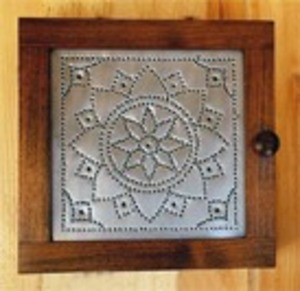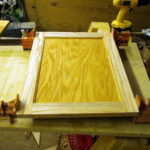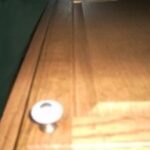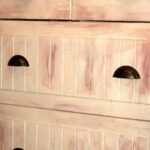Tin punch is the art of punching holes through a tin sheet to create a design. Tin punch art was used American cabinet making to make a “Pie Safe.” For those individuals who are not familiar with a pie safe, it is a cupboard specifically for cooling pies. The holes in the tin panels allowed air to move around the pies while they cooled. While the pies were in the pie safe cooling, the doors also protected the pies from animals, insects and would-be thieves from stealing the pies off the kitchen window sill.
As time progressed, tin punching was seen in decorative items such as candle holders, Christmas tree ornaments and wall hangings. It is still common to see cabinet doors with tin punch inserts. The process of tin punching was popular with craft enthusiasts during the 1980’s and is making a resurgence onto the craft seen during 2011.
Tools used in tin punching include nails, awls, screwdrivers, chisels, hammers and mallets. Common items tin punched by home enthusiasts include recycled food cans, metal sheets and metal tiles. The process does not limit itself to only punching in tin. Copper, brass, nickle-silver and silver sheets between 12 to 30 gauge are available at many craft stores. These sheets are excellent candidates for tin punched projects. Metal tiles used on ceilings and for back splashes are two other prime candidates for tin punching.
The biggest decision to make before beginning the tin punched design is the creation or selection of the design itself. The size of the design is limited to the surface area of the selected metal. Once the design is determined, the tin punching process is simple to complete.
Those individuals new to tin punching should begin their first project on a flat piece of metal. This is the easiest to work with. Center and tape the chosen design on the front of the piece of metal. Locate a piece of scrap lumber to place under the metal. Lay the metal design on top of the lumber. Position the first part of the design directly over the lumber. Place a 7-penny nail or awl on the design mark. Hit the top of the 7-penny nail or awl with a medium hit. Make sure the metal is pierced before removing the nail or awl. Repeat the process on every mark. Turn the metal as needed to ensure the marks are placed over the scrap piece of lumber.
Alternatives to using a nail or awl is making long pierced cuts in the metal using a flat screwdriver or chisel. A phillips screwdriver will create a four pointed star. Use the same process as piercing with a nail or awl as mentioned above.
Carefully remove the completed tin punched article from the wood. Be careful not to cut yourself on the back of the punching. The metal was cut when punched and is sharp. Place the flat tin punched item in a frame. Find the perfect location within the house, on the back porch or on the exterior of the house for placement.








